
Top 13 forest garden species
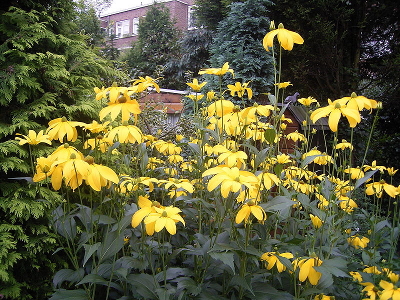 Zev Friedman, vice president
of Living Systems
Design, regaled us
with an exciting talk about Real Life Forest Gardening at the Organic
Grower's School. He included a list of the top 13 species that he
recommends for every forest garden, reproduced below:
Zev Friedman, vice president
of Living Systems
Design, regaled us
with an exciting talk about Real Life Forest Gardening at the Organic
Grower's School. He included a list of the top 13 species that he
recommends for every forest garden, reproduced below:
Sochan aka Cutleaf Coneflower (Rudbeckia
laciniata) is an
herb that can grow in shade or sun, damp or dry soil, and will feed you
spring greens followed by echinacea-like medicine in the summer.
I'd never heard of sochan and would be very curious to hear from
someone who has tried it in their own garden. I have a hard time
believing that sochan would win out over winter kale in a taste test,
but Zev asserts that he's changed over entirely to perennial greens.
Wood
nettle (Laportea
canadensis) is a
shade-loving native that's related to the more familiar (but
non-native) stinging nettle. Zev notes that wood nettle is
tastier but has fewer medicinal properties than stinging nettle.
I have wood nettle growing all over the woods of my property and I've
been meaning to bite the bullet and taste it --- maybe this spring!
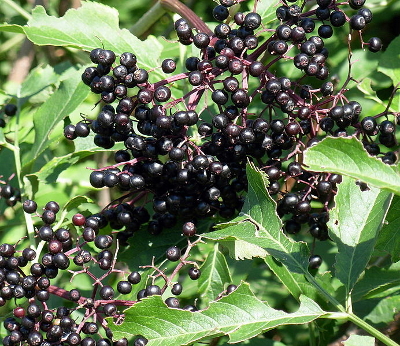 American elderberry (Sambucus
canadensis) is
grown for its fruit, and also for the shrub's vigorous habit that
allows it to form hedges and retain soil along streams. We've got
wild elderberries and I even let a shrub grow up in our forest garden,
but I don't think this plant will become one of our primary food
producers --- very few people eat the fruits raw and we're not
wine-drinkers or jam-eaters.
American elderberry (Sambucus
canadensis) is
grown for its fruit, and also for the shrub's vigorous habit that
allows it to form hedges and retain soil along streams. We've got
wild elderberries and I even let a shrub grow up in our forest garden,
but I don't think this plant will become one of our primary food
producers --- very few people eat the fruits raw and we're not
wine-drinkers or jam-eaters.
Mulberries (Morus alba, M. rubra, and M. nigra) produce edible fruit,
fiber, fodder, and wood for bow-making. I'll eat mulberry fruits,
but I tend to relegate them to the bottom of my taste test list.
Nevertheless, I have planted an ever-bearing
mulberry since the
copious fruits are great for chickens and other animals.
Lamb's
quarter (Chenopodium
album) is a
self-seeding annual green that grows in sunny, disturbed areas. I
suspect this species is of a lot more use to urban gardeners, who can
forage lamb's quarter from an abandoned lot. We try to keep the
weeds down in our garden, so don't provide much habitat for it.
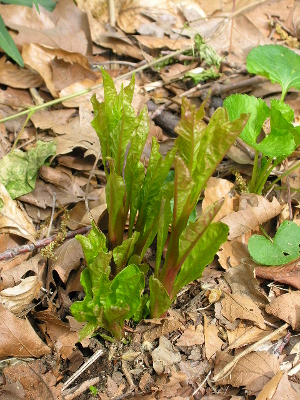 Poke (Phytolacca
americana)
produces edible stalks in the summer. I've always steered clear
of it because I don't believe you get much nutrition after you boil the
greens a few times to remove the toxic substances, but Zev likes the
flavor (with plenty of butter and salt) and notes that poke stimulates
the lymph system just when you need it, at the end of a long winter.
Poke (Phytolacca
americana)
produces edible stalks in the summer. I've always steered clear
of it because I don't believe you get much nutrition after you boil the
greens a few times to remove the toxic substances, but Zev likes the
flavor (with plenty of butter and salt) and notes that poke stimulates
the lymph system just when you need it, at the end of a long winter.
Hybrid
chestnut (Castanea sp.) is grown for its nuts
and wood. American chestnuts used to be a huge component of the
Appalachian diet, and have now been replaced by Chinese
chestnuts. I've planted a few trees in out of the way spots, but
I have to admit that I'm not as keen on this nut as on others --- it's
the one nut that is nutritionally more like a grain. If I was
raising pigs, though, I'd be a chestnut-pusher.
White
oak (Quercus
alba) is grown
for the nuts and wood. I consider oak more of a livestock-food
tree than a human-food tree, but (like poke) the nuts are edible after
leaching out the toxic parts.
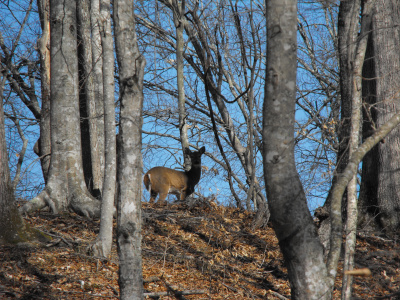 Deer (Odocoileus
virginianus) are
hunted for their meat and skins. Zev notes that deer prune plants
and distribute nitrogen, but that's where I think he's getting a bit
caught up in philosophy and not considering reality (a major downfall
of philosophical forest gardeners who don't garden their own
land.) I'd rather get my nitrogen from an animal that doesn't eat
up every food plant in its path!
Deer (Odocoileus
virginianus) are
hunted for their meat and skins. Zev notes that deer prune plants
and distribute nitrogen, but that's where I think he's getting a bit
caught up in philosophy and not considering reality (a major downfall
of philosophical forest gardeners who don't garden their own
land.) I'd rather get my nitrogen from an animal that doesn't eat
up every food plant in its path!
Heritage
turkey (Melagris
gallopavo) is
grown for its meat. When an audience member (not us, though I was
thinking along the same lines) asked Zev why he suggests turkeys
instead of chickens, he replied that turkeys are more capable of
dealing with predators. I could write for hours about why I think
chickens are better suited to the homestead and forest garden ---
ability to eat food scraps, taste, small size, copious eggs, etc. ---
but I'll let you draw your own conclusions.
Ducks (various species) are grown
for eggs and meat (and to remove slugs from the garden.) I've
read on several blogs, though, that ducks are very difficult to pluck
and that they lay few eggs compared to chickens. I'm sticking to
my working chicken flock.
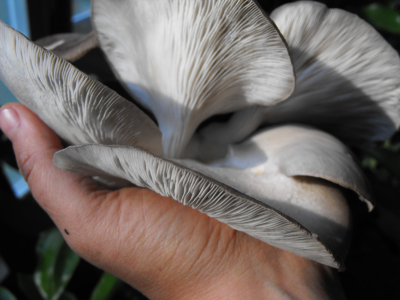 Oyster mushrooms (Pleurotus
sp.) is
(finally!) a recommendation I can get behind whole-heartedly.
We've found that these are the easiest mushrooms to grow in our
climate, can be propagated at home, and are among the tastiest.
Zev notes that in addition to eating the mushrooms, you can also use
them for myco-remediation. (More on that next week.)
Oyster mushrooms (Pleurotus
sp.) is
(finally!) a recommendation I can get behind whole-heartedly.
We've found that these are the easiest mushrooms to grow in our
climate, can be propagated at home, and are among the tastiest.
Zev notes that in addition to eating the mushrooms, you can also use
them for myco-remediation. (More on that next week.)
Appalachian
reishi (Ganoderma tsugae) is a medicinal (and
somewhat culinary) mushroom that is Zev's response to the hemlock
woolly adelgid that is currently wiping out one of Appalachia's
keystone species. If we can't prevent the death of our mighty
hemlocks, Zev notes that we can at least grow some food on the fallen
giants.
After reading through
Zev's list, I can tell that he rates his plants quite differently than
I do. I tend to choose food species first by taste, second by
ease of growing, and only factor in multiple uses at the end.
Zev, on the other hand, clearly chooses first by multiple use, second
by ease of growth, and only considers taste at the very end.
(Either that or his taste buds are just very different from
mine.) Nevertheless, I think we can all learn a lesson just by
looking at his top 13 forest gardening species --- what other list
includes animals and fungi along with plants? We should each work
to create a diversified group of species that together provide greens,
nuts, fruits, mushrooms, and meat. What species would be on your
list?
| This post is part of our Real Forest Gardening lunchtime series.
Read all of the entries: |
Want more in-depth information? Browse through our books.
Or explore more posts by date or by subject.
About us: Anna Hess and Mark Hamilton spent over a decade living self-sufficiently in the mountains of Virginia before moving north to start over from scratch in the foothills of Ohio. They've experimented with permaculture, no-till gardening, trailersteading, home-based microbusinesses and much more, writing about their adventures in both blogs and books.
Want to be notified when new comments are posted on this page? Click on the RSS button after you add a comment to subscribe to the comment feed, or simply check the box beside "email replies to me" while writing your comment.
- Remove comment
 That's a good point about ducks and chickens working well together because they lay at different times of the year --- I'll have to look into that. I'm curious what the duck laying cycle looks like for you. Here, if we have young hens, they lay all year, although they slow down a bit in the winter. Our oldest hens (5 years old) did stop for the winter this winter and last.
That's a good point about ducks and chickens working well together because they lay at different times of the year --- I'll have to look into that. I'm curious what the duck laying cycle looks like for you. Here, if we have young hens, they lay all year, although they slow down a bit in the winter. Our oldest hens (5 years old) did stop for the winter this winter and last.
- Remove comment
